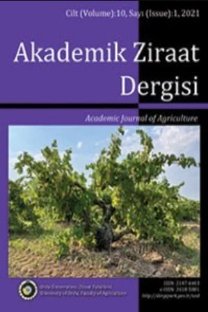Hazelnut culture in Turkey
Öz Turkey is a homeland of hazelnut culture. Hazelnuts are cultivated in the North of Anatolia, called the old and new region. The old region is Eastern Black Sea region and includes Ordu, Giresun, Trabzon, Rize and Artvin provinces. The new region is located in the central and western Black Sea region and includes mainly Samsun, Sinop, Düzce, Sakarya, Zonguldak, Kocaeli provinces.Tombul, Çakıldak and Foşa are the most cultivated varieties. Turkey is the most important producer of hazelnuts of the world with its average of 600 thousand tons. It meets 70% of hazelnut production in the world. Hazelnut constitutes approximately 20% of hazelnut exports of agricultural products of Turkey. Again, hazelnut is the source of livelihood of 400 thousand families living in 3500 villages in Eastern Black Sea Region. The Eastern Black sea region is extremely suitable for hazelnut culture due to its ecology. Hazelnut has been grown for many years and it is intertwined with the social, economic and cultural values of the people of the region. Traditional cultivation practices with intensively labor are common in production periods.
Anahtar Kelimeler:
Corylus avellana, filbert, anatolia, tombul, Black sea region
___
- Anonim, 2011. Fındık Entegre Mücadele Teknik Talimatı. Gıda, Tarım ve Hayvancılık Bakanlığı, Ankara.
- Ayfer, M., A. Uzun, F. Baş, 1986. Türk Fındık Çeşitleri. Ankara. 80 s
- İslam, A. 2000. Clonal Selection in Turkish Hazelnut Cultivars Grown in Ordu Province. PhD Thesis, University of Çukurova, Adana, 192 p (in Turkish)
- İslam, A. 2003. Clonal selection in ‘Uzunmusa’ hazelnut, Plant Breed., 122: 368-371
- İslam, A., Kurt, H. and Turan, A., 2004. Effect on Yield and Nut Quality of Ocak and Single Trunk Training Systems. Sixth Int. Congress on Hazelnut. ActaHorticulturae 686:259-262
- İslam, A., Turan, A., 2013. The Evaluation of Good Agricultural Practices in Hazelnut Growing in Turkey. Proceedings – 24th International Scientific-Expert Conference of Agriculture and Food Industry, Sarajevo, Proceeding Book, 471-474
- Mennan, H. Ngouajiob, M., Isık, D., Kaya, E., 2006. Effects of alternative management systems on weed populations in hazelnut (Corylus avellana L.). Crop Protection 25:835–841
- Okay, A.N., Kaya, A., Küçük, V. Y., Küçük, A. 1986. FındıkTarımı. T.C. Tarım Orman ve Köyişleri Bakanlığı Teşkilatlanma ve Destekleme Genel Müdürlüğü Yayın No: Genel 142, TEDGEM-12, 1986.
- Özenc, N., Caliskan, N., 2000. Effects of husk compost on hazelnut yield and quality. V International Congress on Hazelnut 556
- Özkurt, S. A., 1950. Fındık. Mithat Dördüncü Müessesesi, İstanbul. 77s
- Özkutlu, F.,Korkmaz, K., Özenç, N., Aygün, A., Şahin, Ö., Kahraman,M., Ete, Ö., Akgün, M., Taşkin, B., 2016. Ordu-Merkez Ilçedeki Bazı Fındık Bahçelerinin Mineral Beslenme Durumunun Belirlenmesi. Akademik Ziraat Dergisi 5(2):77-86
- Peker, 1960. Theophrastos ve fındık. Karadenizin milli mahsulü fındığın 2332 yıllık vesikası. İstanbul, 23s.
- Roversi, A., and Malvicini G.L., Mozzone G., Dilmacunal T. 2009. A Simple Summer Pruning Trial on Hazelnut. Acta Hort. 845:367-372
- Thompson M. M. 1982. Breeding for filbert varieties suitable for shelling. Proc. Nut Growers Soc. OR, WA, and BC. 67:35-42
- Tonkaz T., Sahin S., Bostan S. Z., Korkmaz K., 2017. Antioxidant Activity and Phenolic Content of Hazelnut Fruit Grown under Different Irrigation Conditions, IX. International Congress on Hazelnut, 15-19 Ağustos, Samsun
- Tous, J., Girona, J., Tasias, J., 1994. Cultural practices and cost in hazelnut production. Acta Hort 351:395-518
- Tous, J., Rovira, M. 2004. Situation and agronomic perspectives of the cultivation of the hazel. Rural life, 9:41-45
- Tous, J., Romero, A., Plana, J., Sentis, X., Ferrán J., 2005. Effect Of Nitrogen, Boron And Iron Fertilization On Yield And Nut Quality Of ´Negret´ Hazelnut Trees. ISHS Acta Horticulturae 686: 277-280
- Turan, A., and İslam, A., 2018. Effect of drying methods on some chemical characteristics of hazelnuts (Corylus avellana L.) during storage. Journal of the Institute of Science and Technology, 8(3): 11-19. TÜİK, 2016. Tarımsal üretim değerleri, www.tuik.gov.tr (Erişimtarihi: 09/09/2018)
- FAO, 2016. Statistical database, www.fao.org (Erişimtarihi: 09/09/2018).
- ISSN: 2147-6403
- Yayın Aralığı: Yılda 2 Sayı
- Başlangıç: 2012
- Yayıncı: Ordu Üniversitesi Ziraat Fakültesi
Sayıdaki Diğer Makaleler
Muhammed Akif AÇIKGÖZ, Şevket Metin KARA, Ebru BATI AY, Sedanur ODABAŞ
Özgür Barış BİRGÜL, Sezai ALKAN
Ekotiplerin farklı habitatlardaki fenotipik plastisitesi
Agricultural landscape pattern and agricultural tourism potential of Nevsehir
Aslıhan TIRNAKÇI, Esra ÖZHANCI, Meliha AKLIBAŞINDA
Ersin KARAKAYA, Muammer KIRICI, Oğuzhan ÇAM
Sezai ALKAN, Özgür Barış BİRGÜL
